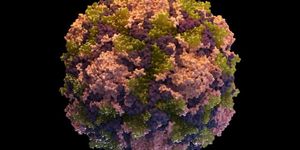Nose Cells Found to Be Likely SARS-CoV-2 Entry Points
Researchers have identified two types of cells in the nose that SARS-CoV-2 probably uses to gain entry to the body and initiate an infection. In the body, human enzymes called proteases (in the case of SARS-CoV-2, the protease is thought to be TMPRSS2) can cleave the coronavirus in two, and one viral fragment binds to a receptor called ACE2 to get into cells. Researchers have now found that in the nose, goblet and ciliated cells have high levels of the TMPRSS2 and ACE2 proteins. The findings, which have been reported in Nature Medicine, can help explain why the virus is transmitted so easily.
"This is the first time these particular cells in the nose have been associated with COVID-19. While there are many factors that contribute to virus transmissibility, our findings are consistent with the rapid infection rates of the virus seen so far. The location of these cells on the surface of the inside of the nose make them highly accessible to the virus, and also may assist with transmission to other people," said Dr. Martijn Nawijn of the University Medical Center Groningen in the Netherlands.
"We found that the receptor protein ACE2 and the TMPRSS2 protease that can activate SARS-CoV-2 entry are expressed in cells in different organs, including the cells on the inner lining of the nose. We then revealed that mucus-producing goblet cells and ciliated cells in the nose had the highest levels of both these COVID-19 virus proteins, of all cells in the airways. This makes these cells the most likely initial infection route for the virus," explained the first author of the study, Dr. Waradon Sungnak.
In this work, the researchers used datasets in the Human Cell Atlas (HCA) to find the cells that express ACE2 and TMPRSS2. They also found cells in the lining of the intestine and the cornea of the eye that the virus can infect. Check out the COVID-19 data at the HCA here.
Even though it has been characterized as a respiratory illness, as more people become infected with the virus, clinicians are reporting that the virus can attack multiple organ systems. For example, there are reports of serious cardiovascular problems, the impairment of the senses of taste and smell, leaking blood vessels, and cytokine storms, in which the immune system begins to attack the body.
This work has also revealed some potential treatment targets for COVID-19.
"As we're building the Human Cell Atlas it is already being used to understand COVID-19 and identify which of our cells are critical for initial infection and transmission. This information can be used to better understand how coronavirus spreads. Knowing which exact cell types are important for virus transmission also provides a basis for developing potential treatments to reduce the spread of the virus," said the senior study author Dr. Sarah Teichmann of the Wellcome Sanger Institute.
Sources: Science Daily via Wellcome Trust Sanger Institute, Nature Medicine









